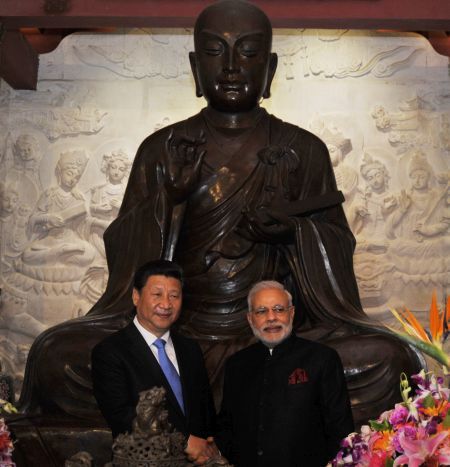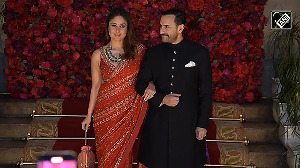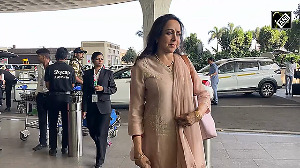
A close reading of the joint statement between India and China suggests that cautious, slow and steady diplomacy continues to remain in vogue between the two countries.
Modi’s arrival has changed the optics of the visit. There is a different demonstration of the confidence level in the Indian leadership, but not much has changed beyond that, reports Sheela Bhatt/Rediff.com.
The ministry of external affairs website has a propaganda video in which it claims to get India-China relations to move from ‘inch to miles’.
Friday’s meeting between Prime Minister Narendra Modi and his Chinese counterpart Li Keqiang in Beijing suggests that both countries are reluctant to move miles in one go. Both the countries will continue to take small steps, slowly but firmly, to keep the forward movement going.
There was unanimous belief about the importance of the visit. “I am pleased to visit China in the first year of my government. This is one of our most important strategic partnerships,” said Modi after meeting President Xi Jinping in Xian on Thursday.
But due to the historic baggage that both countries carry on both sides of the Himalayas, Modi’s first visit to China since becoming PM was seen with cautious optimism.
There was never a doubt that out of Modi’s more than a dozen visits to foreign countries, the ongoing one was the most important. It had raised some hopes after Xi’s visit to Ahmedabad last year, where ‘optics’ acquired a new meaning in diplomacy.
Now the question under debate was -- will it be as historic as the visit of Rajiv Gandhi in 1988 or as significant as Atal Bihari Vajpayee’s visit in 2003 when serious steps were taken to solve the border dispute, when he and Chinese Prime Minister Wen Jiabao agreed to appoint exclusive representatives to settle border disputes? Will the PM's unilateral announcement to grant e-visa to the Chinese really change the template of bilateral relations?
The answer is evident.
Both sides have played cautiously while moving forward, as detailed in the joint statement issued after the delegation level talks on Friday.
It tells us that both sides want a deeper understanding on:
- Strengthening political dialogue and strategic communication.
- Next steps in closer developmental partnership.
- Culture and people-to-people exchanges.
- New avenues for cooperation.
- Trans-border cooperation.
- Shaping the regional and global agenda.
The vexatious border dispute between China and India was obviously not on the table as the summit-level meeting had a macro-focus and wide ranging agenda. But a lot is intertwined in the trust deficit arising from the border dispute between India and China.
Foreign Secretary S Jaishankar said while briefing the media after the talks between Modi and Li that, “No timeline is fixed on border talks, the problem is too complex and too serious to contemplate putting a deadline."
In May 2014, the dramatic change in leadership in New Delhi was viewed with curiosity and hope by China's leaders in Beijing. But a close reading of the joint statement suggests that cautious, slow and steady diplomacy continues to remain in vogue between the two countries. Modi’s arrival has changed the optics of the visit. There is a different demonstration of the confidence level in the Indian leadership as seen in the announcement granting e-visas to the Chinese, but not much has changed beyond that.
A source in the government, who is well-versed with Beijing's thinking, said the Chinese seem to be forming a different perception of Modi between President Xi's visit to India last September and Modi’s visit to China now.
China is not offering a different menu to the new Indian leader, said the source.
Modi wanted to change the matrix and forge a new relationship in the next four years but he was cautious, too. Maybe the Chinese leaders read that shrewdly. Modi is bound to maintain a balance between his nationalist instincts and penchant for big businesses and mega projects for which China is the most suited.
"Modi said when it comes to our relations, there was no question of going back but standing still was also not an option. There's a sense that yes, we have issues, we must address them, but that should not lead us to neglect the opportunities," Jaishankar said as he shared the predicament of the Indian side with the media after the talks.
The Indian side will regret that China is remaining stubborn on the issue of stapled visas and without sorting out this sensitive issue, the Indian side can’t pick up pace on other issues as the Chinese want. The making of Modi as a national leader in India is such that in global diplomacy he can’t put to risk his nationalist fervour, particularly while dealing with China and Pakistan.
Modi’s visit to China draws attention to the reality that in some respects Modi is more handicapped than Vajpayee who enjoyed a centrist-ideology and could sail easily in the muddied waters of diplomacy while remaining the leader of his nationalist party. As Modi has completed state-level visits to America, China, Japan and Europe’s two important countries, it will be worth watching, in the next round, how he brings lucidity to his diplomacy with China and Pakistan.
Jaishankar’s press conference clearly implied that both sides were realistic but not necessarily upbeat to put the relations on the fast track.
It is highly possible that the Chinese leadership’s assessment of Modi is not very different than the Chinese assessment of his party and its mentor, the Rashtriya Swayamsevak Sangh.
However, one will have to wait and see before getting a final view of it.
On the border issue also the same old problem remained unresolved on the table.
While talking about having clarification on the 4,057 km-long Line of Actual Control, Modi said, “I stressed on the need for China to re-consider its approach to some issues that hold us back from realising the full potential of our partnership. We both reiterated our strong commitment to make all efforts to maintain peace and tranquillity in the border region. We should be sensitive to each others' interest."
The joint statement tried to infuse a bit of enthusiasm here and there. It says, 'The Chinese side took note of India’s aspirations to become a member of the Nuclear Suppliers Group, in a bid to strengthen international non-proliferation efforts.'
"For the first time in a document, China has accepted India's aspirations to join the NSG. There is, however, no decision on e-visas with regard to China," Jaishankar said. However, later, at a speech to Chinese students at the TsinghuaUniversity, Modi announced that e-visas will be allowed for Chinese visitors to India.
According to a ministry of external affairs source, "There is no goof-up over the e-visa issue. India has taken the decision. The decision to grant e-visa to Chinese tourists is not a consequence of (high-level) talks."
The MEA source tried to suggest that Modi's announcement of granting e-visa to Chinese travellers is final. "It's a national announcement." And Chinese tourists and businessmen have reason to rejoice because when the visa regime is relaxed it adds to mutual level of trust and increases people to people contacts and also brings business on both sides.
China is reluctant to give round the year river stream data, refuses to stop issuing stapled visa for Indians belonging to Arunachal Pradesh and Jammu and Kashmir travelling to China and is not making any headway on the Indian demand to provide clarifications on the Line of Actual Control.
China's Silk Road and Maritime Route initiative is not being supported by India, yet, nor is there is any substantial announcement on it. Notwithstanding the announcement on e-visas, there is a kind of status quo on how China views India.
Both sides did sign a record 24 agreements worth $10 billion (about Rs 6.3 lakh crore) but the template to deal with each other has not changed much.
Even though Chinese leader Xi Jinping and Modi both are dhandhadari (business-minded), the apprehensions about their respective national security remains where it is.
Image: Prime Minister Narendra Modi with Chinese President Xi Jinping at the Big Wild Goose Pagoda in Xi'an, China. Courtesy: MEA/Flickr.











 © 2025
© 2025